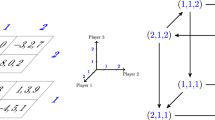Abstract
We experimentally test the predictive success of three stationary concepts in two cyclic duopoly games. The concepts are Nash equilibrium, impulse-balance equilibrium and payoff-sampling equilibrium. In the experiment 11 independent subject groups, consisting out of six participants interacting over 200 rounds, were gathered for each game. The comparison of the three concepts with mixed strategies shows that the order of performance from best to worst is as follows: payoff-sampling equilibrium, impulse-balance equilibrium, and Nash equilibrium. In addition the data exhibit a weak but significant tendency over time in the direction of coordination at a pure strategy equilibrium.
Article PDF
Similar content being viewed by others
Avoid common mistakes on your manuscript.
References
Avrahami, J., Kareev, Y., & Güth, W. (2005). Games of competition in a stochastic environment. Theory and Decision, 59(4), 255–294.
Brown, J., & Rosenthal, R. (1990). Testing the minimax hypothesis: A re-examination of O’Neill’s game experiment. Econometrica, 58, 1065–1081.
Diamond, P. A. (1965). National debt in a neoclassical growth model. The American Economic Review, 55(5), 1126–1150.
Erev, I., & Roth, E. A. (1998). Predicting how people play games: reinforcement learning in experimental games with unique mixed strategy equilibria. American Economic Review, 88(4), 848–881.
Fischbacher, U. (2007). z-tree: Zurich toolbox for readymade economic experiments. Experimental Economics, 10(2), 171–178.
Greiner, B. (2004). An online recruitment system for economic experiments. In K. Kremer & V. Macho (Eds.), GWDG Bericht 63. Forschung und wissenschaftliches Rechnen 2003 (pp. 79–93). Goettingen: Ges. fuer Wiss. Datenverarbeitung.
Kahneman, D., & Tversky, A. (1979). Prospect theory: an analysis of decision under risk. Econometrica, 47(2), 263–291.
Kalai, E., & Lehrer, E. (1993). Rational learning leads to Nash equilibrium. Econometrica, 61(5), 1019–1045.
Osborne, M. J., & Rubinstein, A. (1998). Games with procedurally rational players. American Economic Review, 88(4), 834–847.
Selten, R., & Buchta, J. (1999). Experimental sealed bid first price auctions with directly observed bid functions. In D. Budescu, I. Erev, & R. Zwick (Eds.), Games and human behavior: essays in the honor of Amnon Rapoport. Hillsade: Erlbaum.
Selten, R., & Chmura, T. (2008). Stationary concepts for experimental 2×2 games. American Economic Review, 98(3), 938–966.
Selten, R., & Wooders, M. (2001). Cyclic games: an introduction and some examples. Games and Economic Behavior, 39, 138–152.
Selten, R., Abbink, K., & Cox, R. (2005). Learning direction theory and the winner’s curse. Experimental Economics, 8(1), 5–20.
Author information
Authors and Affiliations
Corresponding author
Electronic Supplementary Material
Rights and permissions
Open Access This is an open access article distributed under the terms of the Creative Commons Attribution Noncommercial License (https://creativecommons.org/licenses/by-nc/2.0), which permits any noncommercial use, distribution, and reproduction in any medium, provided the original author(s) and source are credited.
About this article
Cite this article
Goerg, S.J., Selten, R. Experimental investigation of stationary concepts in cyclic duopoly games. Exp Econ 12, 253–271 (2009). https://doi.org/10.1007/s10683-009-9218-8
Received:
Accepted:
Published:
Issue Date:
DOI: https://doi.org/10.1007/s10683-009-9218-8




